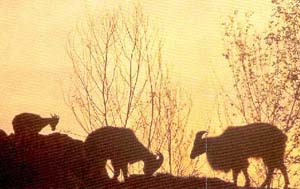 |
|
General Information
Originally from the Himalayan mountains, these magnificent mountain goats were liberated in New Zealand's Southern Alps in 1904.
Although both sexes have horns, those of the bull are longer and heavier than the nannies.
Despite their size and relativley short legs the Bull is an extremely agile animal that can bound down through the steepest of bluff systems with their hooves barely touching the rock faces.
The dense, wooly winter coat is reddish to dark brown and has a thick undercoat. Bull has Lion like mane that often exceeds over a foot in length.
After the spring molt, the coat is much shorter and lighter in colour.
The legs are relatively short, and the head is proportionally small. The eyes are large, and the ears are small and pointed.
The horns are triangular in cross-section and are found in both sexes. They curve upward, backwards, and then inwards & are usually larger in males.
Behaviour
Most active during the early morning and late afternoon, Himalayan tahrs
spend the middle of the day resting among rocks and vegetation.
Very shy and wary, they are difficult to approach, especially from downhill. When startled, they flee confidently. The Himalayan tahr may migrate down the mountain during the winter, resting in denser cover at lower altitudes as protection from the elements.
When competing for breeding privileges, males lock horns and attempt to throw each other off balance, although compared to other ungulates this is done in a somewhat half-hearted manner.
Habitat
Rugged mountain country and montane woodlands in the Himalayan mountains.
Back to the top
Feeding and Breeding
Diet: Grasses, leaves. Main Predators: Leopard, snow leopard.
They live in family groups as mixed herds of about 15 animals, with up to 80 in one group. Old bucks are usually solitary.
Gestation Period: 7 months. Young per Birth: 1, rarely 2 The rut, or breeding season, occurs from October to January.
Conservation
The Himalayan tahr is considered vulnerable by the IUCN (1996).
Bull tahr are the king of the mountain as they inhabit the highest peaks in the Southern Alps & is considered
A world class trophy for game hunts in New Zealand . They fetch a price of $3000!
The rutt for the bull tahr is from May through to August which they group up with their females. The bull tahr produce one of the best capes and neck mane of any feral animal.
Interesting Facts
Tahr is from thar, the Nepalese name for this animal.
Interesting Facts :- Hemi (Greek) half; tragos (Greek) a goat: meaning 'something like a goat', referring to the animal's combination of having and not having certain goat-like characteristics. Jemlah, probably from hima (Sanskrit) snow; alaya (Sanskrit) an abode [hence also Himalaya]; -icus (L) suffix meaning belonging to.
Bibliography
*Grzimek's Encyclopedia of Mammals. Volume 5. Pages 512-513, 542.

